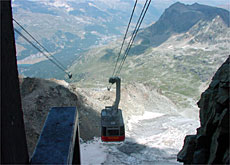Permafrost gives cable cars that sinking feeling

Some 15 per cent of Switzerland’s cable car installations may be at risk of collapse because of rising temperatures.
The structures in question are anchored in permafrost – frozen ground that holds many of Switzerland’s mountains together.
One solution is to put metal anchors near the foundations to keep the rock firm as the permafrost thaws. Another is to relocate cable car stations which are in places deemed to be at risk.
But a recent study near St Moritz revealed that some areas may be potentially so unstable that even the drastic step of dismantling and rebuilding a station nearby might not be feasible.
Three years ago, a cable car operator near the Graubünden resort wanted to know whether the top station on one of the highest peaks in the area could be safely moved a few hundred metres from its current position.
At 3,300 metres, the Corvatsch station sits below the peak of the same name and offers stunning views across the Alps.
A new cable car now operates from Surlej (1,870 metres) to the middle station, Murtel (2,700 metres) but the installation at the top is 35 years old and needs rebuilding.
Deadline
Permafrost expert Felix Keller of the Engadine Academy was asked to assess the feasibility of relocating the station.
Faced with a tight deadline, Keller needed to know what kind of rock glacier ice he was dealing with.
Since the cables of the new structure alone would weigh 250 tons, the stability of the bedrock was a crucial question.
One of his first tasks was to examine aerial pictures from 1955. He found that, since then, the adjoining glacier had retreated some 40 metres.
“We knew that this part of the bedrock had only been free of ice for 20-30 years,” said Keller. “It was possible something had changed within the hydrology of the bedrock.”
By drilling boreholes, Keller was able to ascertain that the temperature in the top ten to 20 metres of the permafrost was about minus 3.6 degrees Centigrade.
Laboratory experiments and computer modelling at different temperatures and different stress revealed that the bedrock would be stable at minus five degrees.
Water loss
Furthermore, although the bedrock seemed sound initially, at a depth of about 14 metres, water loss was occurring.
This, combined with the fact that the area was riddled with cracks, caused the team to have serious doubts.
“We were really not sure about the stability of the whole building because five years before, a large crack opened between the restaurant and the cable station,” said Keller.
He rapidly concluded that it was impossible to build at the new site and that even at the existing location, the operators would need to watch temperatures carefully.
Closely scrutinised
Keller was working in one of the most closely scrutinised permafrost areas in the Alps – the Murtèl-Corvatsch region. Temperatures there have been measured since 1987 in a borehole on the rock glacier Murtèl.
Between 1987 and 1994, the uppermost 25 metres warmed rapidly by almost a degree Centigrade followed by intensive cooling from 1994 to 1996 when temperatures reached levels similar to those in 1987.
Since 1996, permafrost temperatures have increased again.
Experts agree that only long-term monitoring can provide answers about the behaviour of permafrost, and the potential threat to high-altitude structures such as cable cars.
Monitoring these areas is a challenge in itself – conditions are hostile and avalanches regularly disrupt research work. Last winter, a powder avalanche destroyed the Murtèl researchers’ sensors and masts and carried them 300 metres down the mountain.
The work will have to continue, though: some 288 of Switzerland’s 1,894 cable car installations are anchored in permafrost, and they span a distance of about 150 kilometres out of a total 1,955 kilometres.
swissinfo, Vincent Landon
Between four and six per cent of Switzerland is covered by permafrost.
In Alpine regions above 2,500 metres, 33 per cent of the area is covered in permanently frozen ground.
Scientists are keen to know the impact of climate change.
Extensive research on the phenomenon is taking place is the St Moritz region.
Some 288 of Switzerland’s 1,894 cable car installations are anchored in permafrost.

In compliance with the JTI standards
More: SWI swissinfo.ch certified by the Journalism Trust Initiative











You can find an overview of ongoing debates with our journalists here . Please join us!
If you want to start a conversation about a topic raised in this article or want to report factual errors, email us at english@swissinfo.ch.